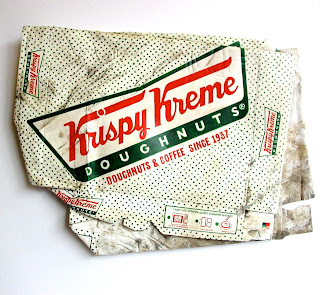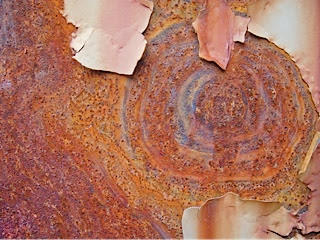Tom Pfannerstill: More from the Street
Ron Gregory: Just Rust
Reviewed by Keith Waits.
Entire contents copyright © 2013, Keith Waits, all rights reserved.
,acrylic+on+carved+wood,+2013.jpg) |
| Tom Pfannerstill, Krispy Kreme (doz), acrylic on carved wood, 2013. |
When is found object art not found object art? In the work of two artists now on display at Galerie Hertz, objects are “found” and used as significant resource, but never themselves make their way into the gallery.
Tom Pfannerstill is very familiar to the Louisville visual arts scene, and the new work here on exhibit continues his amazing string of trompe l’oeil sculptures that have been described by one esteemed sculptor as “genius.” The gallery walls are adorned with squashed boxes, wrappers, bags, cans and other containers – commercial packaging found littering streets and alleyways around town. Distressed to a point where the original purpose begins to be obliterated, it represents the tawdry detritus of a consumerist society choking itself to death.
Yet Mr. Pfannerstill has again discarded these items (this time with more care, one assumes) and replaced them with facsimiles carved from wood and painted in such exacting, replicating detail that never fails to astonish. One must resist the temptation to brush the surface with a fingertip – the better to investigate the reality of each fold, tear or grease smudge. That grungy quality is so fully realized that washing your hands immediately after would seem in order. The one missing element of the illusion is smell. This art should stink.
 |
| Tom Pfannerstill, Auto Zone Anti Freeze, acrylic on carved wood, 2013. |
We can also be grateful that the artist doesn’t overreach in his statements about the work, but the results are more than formal exercises in dazzling technique, or overly clever intellectual mind games. The craftsmanship captures the viewer and holds his or her attention long enough to invite the mind in on whatever levels it chooses to engage. When art makes the viewer this active a participant, it competes well enough with the bombardment of digital overload that dominates our daily visual appetite.
The pairing of Pfannerstill’s sculptures with the digital images of Ron Gregory is apt, not only because of a long-standing friendship, but because Gregory here also explores the ragged and neglected aspect of objects that, while occupying more permanent locations geographically, are fixtures suffering from neglect and often found in alleyways and other less-traveled paths. Various waste and storage containers display abused and scarred metal skin, the glossy surfaces deteriorating and revealing layers of rust and raw metal, exposing color and texture that, in its abstraction, becomes beautiful and compelling. Fauvist fields of color are captured, and the great sweeping disruptions of the surface are violent in their impact, creating dynamic compositions that might be the envy of some painters. The artist may have come across some of these images at random; but the choices made are as important as another artist placing paint to canvas, and the expanding of detail to become the entirety of the image is impressive.
 |
| Ron Gregory, Metal Roof Panel of Steel Tool Shed, C-Print on Recycled Aluminum, 2013. |
In “Paper Waste Compactor Side Wall,” the painted surface, a vivid saturation of temperature and color tending to gold, is covered with a fine, spidery network of delicate lines. The image is striking for the balance of heat, beauty and first encroaching decay of time and neglect. In another image, “Abandoned Commercial Storage Locker,” the last flakes of paint cling desperately to the object; yet we almost wish they would make their final departure, as they almost distract from the deep hues of red and blue revealed in a magnificent spiral of rust.
The contrast between the two bodies of work is, of course, that while Mr. Gregory’s photographs illuminate beauty that occludes the source objects, Mr. Pfannerstill seems to be reveling in the nature of the object itself. One celebrates the beauty of the effect of the laws of nature on man-made constructions, while the other forces us to identify more transient pieces of our world and compels us to contemplate our own relationship to the object and its symbolic meaning in our lives.
Exhibition closes May 18.
Tues.-Fri. 11 a.m. – 5 p.m.
Sat. 11 a.m. – 3 p.m.
Galerie Hertz
1253 S. Preston Street
Louisville, KY 40206
502-581-8277






